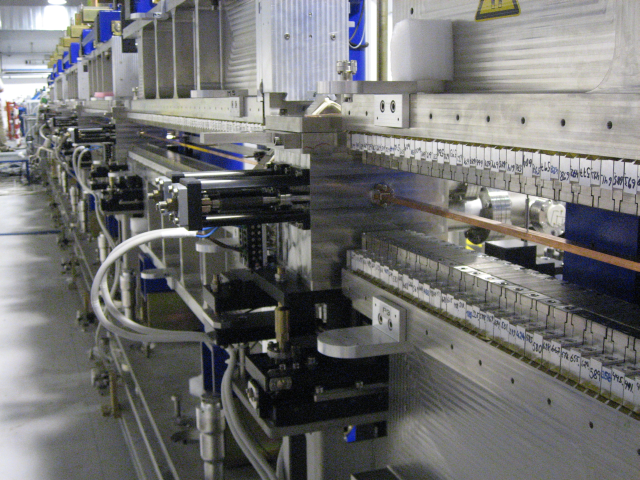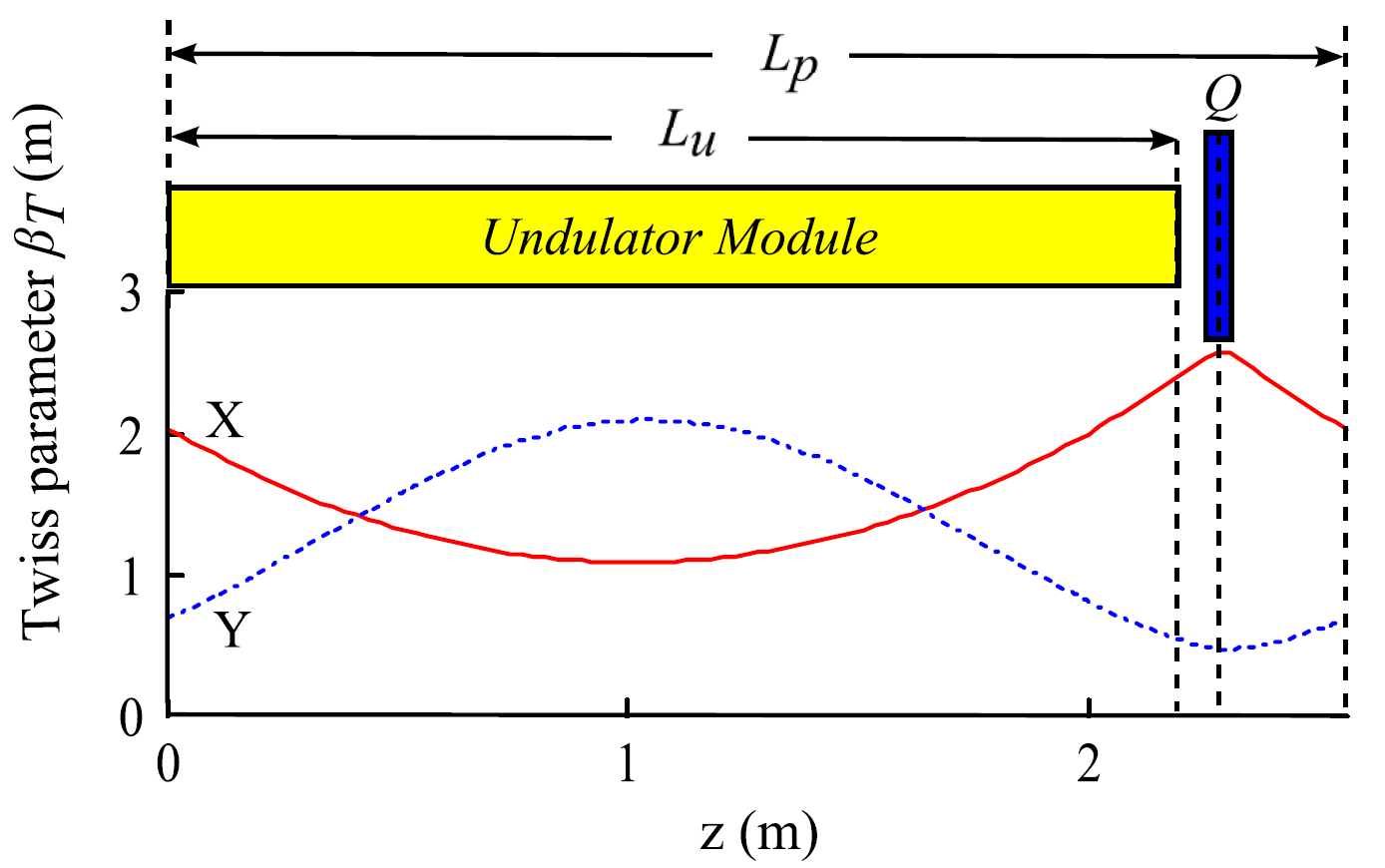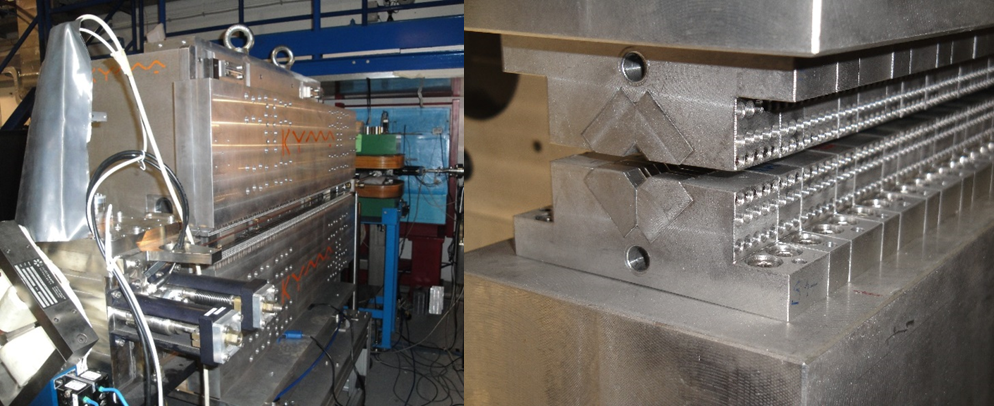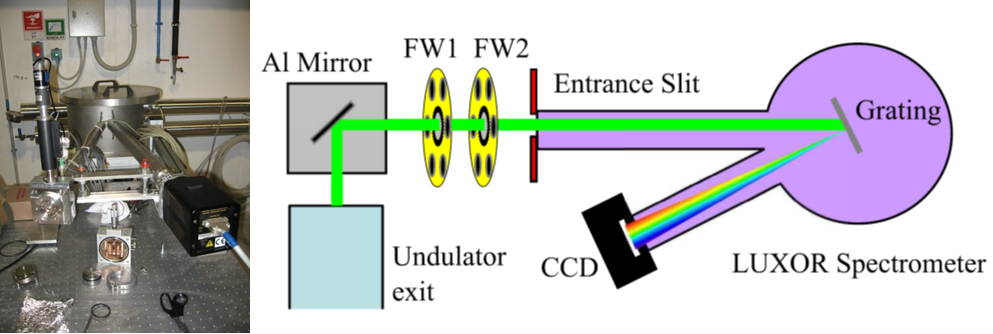Undulators
The Undulator consists of six permanent magnet modules made by 75 periods (77 including two termination periods) with $\lambda_u$=2.8 cm long. Each module allows a variable gap in the range from 25 to 8.4 mm in order to achieve an undulator strength parameter variation up to $K_u$=2.2 at the minimum gap, this value limited by the presence of a vacuum chamber for the propagation of the electron beam.

Undulator line of the SPARC FEL
The intersections between the undulator modules host quadrupoles for horizontal focusing and radiation diagnostic stations. Each station is equipped with actuators allowing the insertion of alumina screens to monitor the electron beam size and position, and aluminum mirrors to extract the radiation.

Layout of the SPARC_LAB FEL with six ACCEL modules
Two triplets of quadrupoles ensure the matching of the electron beam to be suitable with the required dimension and divergence of the beam into the undulator to optimize transport and maximize the FEL performances.

FODO element of the Undulator line with the shape of the Twiss beta parameter in the transverse and radial direction
More recently a novel type of short period undulator with $\lambda_u$ =1.4 cm and $K_u$=1, developed by ENEA and made by Kyma, have been installed and tested. This undulator replaced the last ACCEL modules and acts as an afterburner to have emission of radiation tuned at harmonics of the main resonance wavelength of the ACCEL modules. This undulator is a permanent magnet type 1.5 meters long with a Delta structure to minimize the gap between the magnetic bars allowing space for installation of a round in-vacuum waveguide with 5 mm external diameter.

Layout of the SPARC_LAB FEL with the ENEA-Kyma afterburner

ENEA-Kyma short period Δ afterburner
FEL diagnostics
The main diagnostic used to measure the output radiation is an in-vacuum spectrometer built by the LUXOR laboratory (Padova), at the end of the undulator sequence. The instrument is a 1 m normal incidence grating spectrometer with a Princeton UV grade CCD camera, allowing the detection of spectra both in single shot and in integrated mode. The spectrometer spectral range covers the interval 35 – 800 nm with three different gratings (600, 1200, 2400 grooves=mm) operating at different wavelengths. The CCD camera and the necessary upstream optics were calibrated in energy. The spectral image permits the reconstruction of the total pulse energy together with the spectral parameters as central wavelength, linewidth, and, in the vertical direction, of the spot size and position of the radiation beam.
Different filters are available along the radiation beam line, mounted on two filter wheels (FW1, FW2). Neutral density filters allow the attenuation of the radiation intensity at the CCD for wavelengths longer than 350 nm. Bandpass filters may be used to remove intense signals from long wavelengths while observing the higher order harmonics of the FEL.
Other diagnostics includes photodiodes and energy meters, CCD cameras, a broadband fiber spectrometer and, recently, a commercial IR FROG.

Setup of the Luxor Spectrometer
Publication Highlights
- “Magnetic Measurement System for the SPARC Insertion Devices”, M. Quattromini et al., proc. EPAC 2008, WEPC124, available at www.jacow.org
- “Segmented undulator operation at the SPARC-FEL test facility”, F. Ciocci et al., Proceedings SPIE Volume 9512, Advances in X-ray Free-Electron Lasers Instrumentation III; pag 951203 (2015), doi: 10.1117/12.2185099
- “High-order laser harmonics detection in the EUV and soft x-ray spectral regions”, L. Poletto et al., Rev. Sci. Instrum. vol. 72, (2001) pag. 2868, doi: 10.1063/1.1378342
- “Spectral and intensity diagnostics of the SPARC free-electron-laser”, L. Poletto et al., J. Phys.: Conf. Series, vol. 425, (2013) pag. 122011, doi: 10.1088/1742-6596/425/12/122011
- “Focusing properties of linear undulators”, M.Quattromini et al, Phys. Rev. ST: Acc. Beam, vol. 15 (2012), pag. 080704, doi: 10.1103/PhysRevSTAB.15.080704
- “The SABIA terahertz/infrared beamline at SPARC-LAB facility”, S. Macis et al., Proceedings of 12th IPAC (2021), pag. TUAB069, doi: 10.18429/JACoW-IPAC2021-TUPAB069
- “Design of the innovative Apple-X AX-55 for SABINA project, INFN – Laboratori Nazionali di Frascati”, J. Počkar et al., Proceedings of 40th Int. FEL conf. (2022), pag WEP47, doi: 10.18429/JACoW-FEL2022-WEP47
- “Strain measurements of the Apple-X SABINA undulator with fiber Bragg grating”, I. Balossino et al., Proceedings of 15th IPAC (2024) pag THPS21, doi: 10.18429/JACoW-IPAC2024-THPS21
Contact person: A. Petralia, alberto.petralia@enea.it

